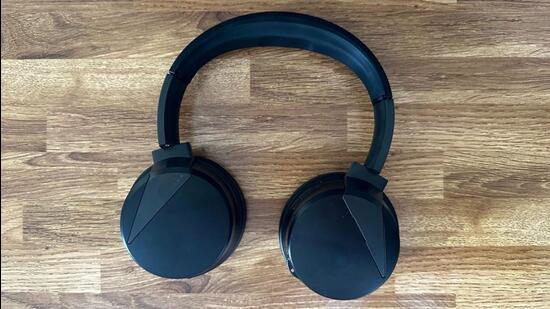It isn’t often that we classify developments with headphone tech as ‘intriguing’. But for Indian tech company Rapture Innovation Labs to achieve what they have in terms of experience, the very approach to headphones may change soon enough. Inspiration for these Sonic Lamb headphones, in a way comes from how classical music composer Ludwig van Beethoven compensated for hearing loss by letting his body transmit the music to his brain.

Therefore, the claims of being the world’s first headphones with patented hybrid driver acoustics, that combine air and body conduction. Specifically, bone conduction. You may find a few in the wired earphone space, such as the Astell & Kern Pathfinder and the FIIO FH9. Less so, among headphones, and not to be confused with dynamic drivers which logically sit a step lower in the hierarchy of headphone driver tech.
Sonic Lamb headphones, in each ear, combine a dynamic audio driver and a hybrid subwoofer unit. Sounds simple? It isn’t. While audio drivers reproduce mid and high frequencies with air conduction, bass and lower frequencies are therefore also dealt with in the same way. As a result, headphones tend to feel like closed boxes with bass booming straight towards your ear drums.
Also read:Devialet Mania is a definitive case for portability as a passage to luxury audio
The proprietary subwoofer instead uses the thick earpads as a virtual diaphragm to carry the mechanical impulses. The earpads sit up against the skin and our skeletal structure. You can do the math.
On that point, we must note that though plush and comfortable, the earpads and the headband tend to suffer from very perceptible wrinkling. Over a period of time, that may not be a good sign. Could this be an indicator of a thinner material being used? Perhaps, but longevity will struggle as too much flex will lead to an inevitable tear. It’ll start small, but that’s the point of no return.
Another aspect where some work is needed, is the quality and feedback from the three physical buttons – pairing and volume. There is little feedback when they’re pressed, and the recessed design makes them hard for fingers to detect as you’re wearing the headphones. Mind you, our review unit is one that is part of the ‘beta’ stage, and there is expectation the tactile feedback issue would be resolved in retail units going forward.
The bone conduction proposition, isn’t just some fancy claim for the spec sheet. Our tryst with a variety of lower frequency across music genres made it amply clear how well this has been implemented. There are times when the bass feels like it’s surrounding your ears, and at other times, it’s spiraling as a very audible secondary layer as the rest of the soundstage takes the forefront. Think of this in terms of what a larger, home theatre subwoofer would do with the gentle rumble that moves across the room in waves.
Also read:Sennheiser’s Ambeo Soundbar Plus stays true to basics of good home theatre sound
That is crucial, when coupled with the width of sound, because vocals as well as detailing from mid-frequencies comes through in the sort of pristine manner that one expects from headphones of the ilk of the Apple AirPods Max and the Sennheiser Momentum 4, both of which are more expensive in differing degrees. Good time this, to talk about the pricing. Sonic Lamb headphones are priced at ₹19,999 which gives them definite value potential, even more so if you can buy one for ₹15,999 which will be the price for a limited duration.
But that’s where the Sonic Lamb turns to its party piece. Admittedly, the naming scheme could have been better. On the headphone, you’ll notice a dial, that deploys some magic.
The primary mode is ‘Hear’, which tries to keep the sound signature quite neutral. This will be ideal for quite a few music genres and if you aren’t in the mood to listen to powerful bass, podcasts, audio books and phone calls (if that’s what you’re comfortable with, on a headphone).
Also read:LG S95QR sets premium audio aspirations amid competition with Bose and Sony
Slide this to ‘Feel’ and a slightly more ‘V-shaped’ equaliser pre-set kicks in. It isn’t a lot, but this is where the subwoofer begins to make its presence felt at times, when the music demands it. Should still work for podcasts or commentary, alongside up-tempo music. Ideal for classic rock, which says a lot about Sonic Lamb’s versatility since headphones usually struggle to find the ideal tuning for the 80’s rock to stream through to your ears as it is meant to.
‘Immerse’ is the mode you’d probably like to lock in if your playlists are defined by dance, techno, R&B and remix tracks. There is a very satisfying level of bass in this mode, as the subwoofer does its job really well without overshadowing mid or lower frequencies. The bass doesn’t sound unpleasant, which itself is a win for the tuning.
That makes us wonder, do you really need to go the whole distance into the “Beast” mode for music. The key to switching to this perhaps is if you are watching movies on your iPad for instance – there’s a significant depth added to the sound, which is ideal for the multi-layered soundstage action movies tend to have.
Also read:Sennheiser IE 200 reminds us of a simpler connection with music, and the past
One of the modern-day requirements revolves around a companion app for smartphones, but for now, Sonic Lamb misses out on that. The app is expected soon for Android devices and the iPhone, which means there’s little you can do in terms of customising sound or even turning on or off the codecs (if at all that feature is replicated). Keeping an eye on battery level, therefore requires a couple of steps via a phone’s Bluetooth menu.
Also, there is a cool white tone LED on the headphone, which persistently blinks when you’re streaming music from a phone or a tablet or any other device. This is, if you are using the Sonic Lamb in a dimly lit or a totally dark room, shines a tad too brightly. Alas, no way yet to dim this, or turn it off completely.
The highlight will be the audio personalisation feature, a test that’ll customise sound according to the frequencies your ear can hear. It’s been done before by the likes of Jabra before, which will make it interesting to see what the great minds at Rapture Innovation Labs’ do differently.
We don’t often say this. Sonic Lamb headphones are building from what is already a very high baseline of audio performance. Yet, it is undeniable that quite a few rough edges need to be ironed out. Build and materials being one, the app for phones the other. There’s work to be done, but most of these should be easy fixes considering the core of the experience, which is the sound and the four distinctly tuned modes, work as flawlessly as they are expected to.
